#the liberation of playing a character i’m not worried about making likable
Explore tagged Tumblr posts
Text
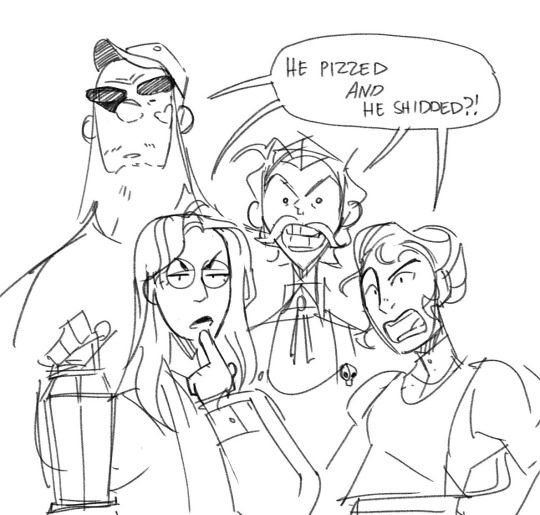

daily sketch 2023 || aug 21st
we were truly in silly mode during yee hawnted last night. said pizz and shidd and sneople and snerson so much
also wanted to draw doc wolf with his mule who doesn’t like him (because no animals trust him)
#artists on tumblr#ocs#sketchbook#daily sketch#dailies 2023#daily sketching#coc: down darker trails#oc: wolf#playing doc wolf is honestly some of the most fun because he’s so fucking annoying#the liberation of playing a character i’m not worried about making likable#(wouldn’t do it all the time but it’s fun to try something new!)
12 notes
·
View notes
Text
Yakkin ‘bout Games: Wolfenstein: The New Order
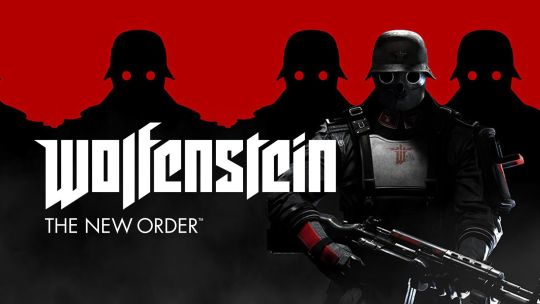
Yakking ‘bout Games is a series where I talk about games that I’m currently playing or have just finished. It can be new or old, console or PC, good or bad, it really doesn’t matter. If it’s a game worth talking about, you’ll see it covered here.
I think it’s fair to say that the FPS genre has enjoyed a bit of a renaissance over the last decade and a bit. The modern military shooters that dominated the late 2000s and early 2010s have become less common. We have seen the return of classic franchises like Doom and Half-Life, and we have also witnessed the influx of “boomer shooters” like Dusk and Amid Evil. A lot of cool stuff indeed.
With that being said, let’s take a trip back a few years. 2014 to be exact.
This was the first year of the (then) brand spanking new PlayStation 4 and Xbox One. The two consoles were not off to the best of starts though. Their early exclusives like Killzone Shadow Fall, InFamous Second Son, Forza Motorsport 5 and Dead Rising 3 had failed to impress. The only games picking up the slack were multi-platform releases like Assassin’s Creed IV Black Flag. The only FPS games available at the time (other than Killzone on PS4) were Call of Duty Ghosts (dull as dishwater) and Battlefield 4 (I enjoyed it but it was completely broken on release.)
Not exactly the most exciting of times for an FPS fan on console.
Wolfenstein: The New Order finally came along that May. It had been announced the year prior but it didn’t have much fanfare behind it. The initial E3 showing didn’t really impress anyone and there wasn’t really a great excitement for the game’s release. Perhaps it was because the previous Wolfenstein game was largely ignored by people or maybe because people were skeptical due to the game being MachineGames’ (the developer) first effort. People needn’t have worried though. The game turned out to be a massive surprise. It ended up being one of the best of that year.
Why am I covering this now? It’s because I recently got the urge to play it again after all these years. Plus I wanted to see how it would function in a post modern Doom world. So with that in mind, let’s get psyched and see how the game holds up.
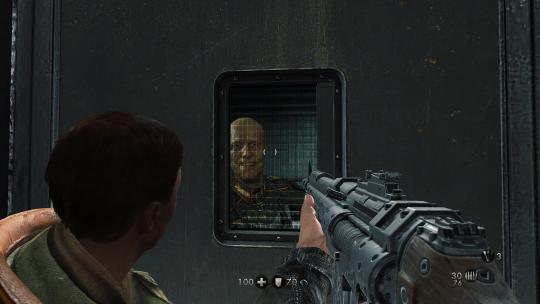
Never has a smile brought terror to my heart so fast. Well this and my last dental appointment...
The New Order is set in an alternate universe where the Nazis won World War II due to their advanced technology being too much for the Allied forces. After an operation to try and assassinate the spearhead behind this growing technological evolution goes horribly wrong, Captain William “B.J.” Blazkowicz ends up taking a piece of shrapnel to the back of the head which puts him into a vegetative state. He ends up spending fourteen years in a Polish mental asylum before finally being awoken again due to witnessing a horrible atrocity committed by the Nazis. B.J. is now in the alien world of 1960 where the Nazis rule over the world with an iron fist. It’s up to B.J. to link up with the remnants of the Resistance and take the fight back to the Nazis once and for all.
The story was and still is one of the most surprising elements of The New Order. It paints a brutal picture of a world controlled by an evil and ruthless force who will stop at nothing to assert their dominance. The cast as well are very memorable. You have the plucky and likable Resistance fighters who you get to spend quite a bit of time with. You then have some memorable encounters with the evil figureheads of the Nazi regime at certain parts of the story. Anyone who has seen the train sequence in this game knows exactly what I’m taking about. I have to give MachineGames credit as well for the characterisation of B.J. himself. They managed to turn a character who was known for being a badass Nazi killer to a very sympathetic and likable Nazi killer. B.J. in this game is weary and tired after years of fighting evil and tyranny at every corner. The man wants nothing more than for the war to be over so he can hang up his guns and finally settle down. How could you hate the man after hearing something like that?
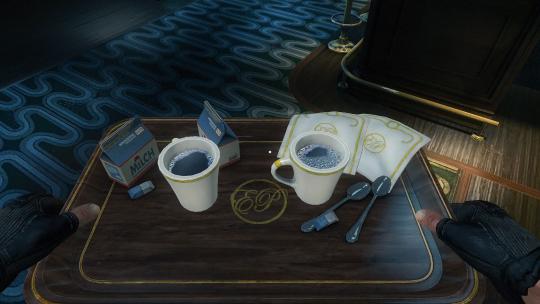
B.J. is such an upstanding guy that he would infiltrate a Nazi controlled train just to get you some coffee. Liberation and a Cappuccino, you can’t beat it.
The real bread and butter of The New Order though is the gameplay. It has held up fantastically for the most part. Combat is a blast thanks to the very meaty arsenal at your disposal including assault rifles, shotguns, marksman rifle and a Laserkraftwerk which allows you to blast enemies to smithereens. You’ll have plenty of enemy types to cut through including rank and file soldiers, big mech suit soldiers with heavy weaponry and robots that have massive lasers. B.J. has a few abilities though to help turn the tide of battle. Leaning is one such ability and it’s implemented very well. How it works is that if you hold the L1 button, it locks B.J. in place and you can then use the left stick to lean at different angles. It’s super useful. Earning a well placed few shots at a Nazi from a very awkward angle never gets old. B.J. also has the ability to dual-wield certain weapons to deal even more hefty damage to his foes. Press up on the d-pad and prepare to bring the carnage. While this is a pretty fun feature, it does limit your movement speed and it can result in you burning through ammo quite quickly. It also is restricted to two types of the same weapon. You can also find upgrades for weapons which give them different ammo types and fire modes. The Laserkraftwerk, for example, can be used to cut through certain boxes and materials which is pretty nifty.
In terms of how health works, it’s a hybrid between classic pick-ups and regeneration. You can recover health by picking up health packs and food throughout the game. Armor can be found as well to allow you to take some extra damage. If you take health damage and managed to find cover, you’ll eventually get 10 health points back. You also have the ability to overcharge your health. How this works is that if you end up picking up a health item that takes you over your max health, you get higher health points for a brief period which is quite useful. You can increase your max health by finding hidden health upgrades throughout some of the levels.
AI is decent for the most part. They will attempt to find cover in the heat of a firefight and they do try to flank you. Some of the heavy soldiers will also attempt to rush your position. I certainly didn’t notice any unusual behaviour from them. Boss fights are a bit unremarkable for the most part. The game pretty much spells out how to take them out and they don’t really put up much of a fight. The main exception being the final boss but even then, it really isn’t that hard.
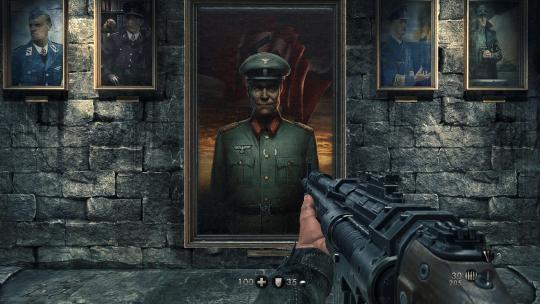
The secret painting boss fight was an interesting idea though. Definitely a canvas for them to work on in the future. (Apologies for the bad pun and joke.)
The game does have a basic stealth system and it works fine. When you enter most of the areas in the game, you will be informed that there are two commanders in the area. Take them out without being spotted and you can sneak through the area without having to worry about reinforcements if you get spotted by an enemy. You can take down enemies stealthily by using a silenced pistol, throwing knives or by sneaking up to them and performing a takedown. Stealth can feel a little overpowered during some of the early sections because the pistol is super accurate and it only takes one headshot to take some of these enemies down. The game does balance this a bit better later on as areas are populated with more elite enemies that harder to kill without being spotted.
Being a Wolfenstein game, you would expect exploration to be a big part of the gameplay and it does play a part for sure. There are hidden areas to be found with collectibles such as the Enigma codes which can unlock new difficulties and cheat codes. You can also find hidden max HP upgrades and other stuff as well. Maps can be found in each level which will indicate possible hidden secrets with a question mark. Levels are definitely more linear than some of the prior Wolfenstein games so don’t expect huge hidden areas or levels.
Key and item hunting still exists of course. You will find doors that require a key or a tool needed to progress which requires a bit of skulking around to find that key or item. You see this especially in the Resistance HQ sections which occur after most of the levels. In these sections, you will be tasked with finding a certain item for a character to progress to the next level. There are also side missions where you can do the same thing for other characters in the HQ and completing these unlocks extras such as artwork. I’m mixed on the Resistance HQ sections overall. On the one hand, they’re good from a lore perspective because you can overhear conversations from some of the characters and there are newspaper clippings and notes to find which do a good job of building up the world. On the other hand, they do feel a little bit like filler. Swings and roundabouts, I suppose...
I don’t really have many issues with the gameplay as a whole. My only real gripe is how the weapon wheel works. Weapon wheels are commonplace on console because a controller doesn’t have many buttons when compared to a keyboard. Makes perfect sense. The New Order’s one however can be such a temperamental thing to use. How it’s supposed to work is that you hit the R1 button to bring up the wheel and then you use the right stick to pick the weapon you want. Sounds simple enough. In reality what happens is that the game ends up giving you the wrong weapon time after time. I can’t even begin to count the amount of times that I tried to switch to the assault rifle and the game switched me to the dual-wield pistols instead. It can be a bloody nuisance. Part of this is down to how sensitive the stick is when using the wheel. It’s way too fast. Also why do the dual-wield options even need to be there? You can already hit up on the d-pad to dual-wield a particular weapon plus I didn’t really need to dual-wield all that much so it’s just clutter. They could have cleaned this up a lot better. I also had issues with swapping back to the previous weapon. It would sometimes default back to the Laserkraftwerk even though it wasn’t my previous weapon. Thankfully these issues didn’t get me killed but they certainly got on my nerves a little bit.
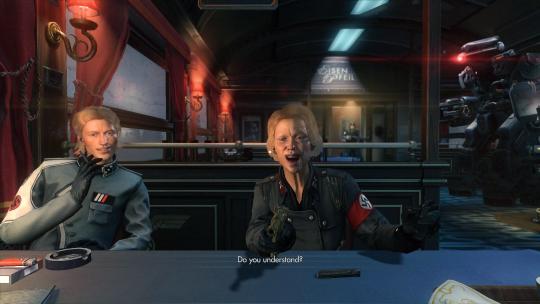
Textbook schadenfreude here from one of the villains. Shouldn’t be that shocked really...
From a graphics point of view, Wolfenstein: The New Order still holds up remarkably well. It runs on the same idTech engine that powered Rage before it and it certainly looks great. Character models are well detailed and they animate well. Cutscenes are well framed and the angles are perfectly done. Environments are beautifully crafted with amazing detail so whether you are in rainy soaked London or even the friggin’ Moon, you feel immersed in the world of the game.
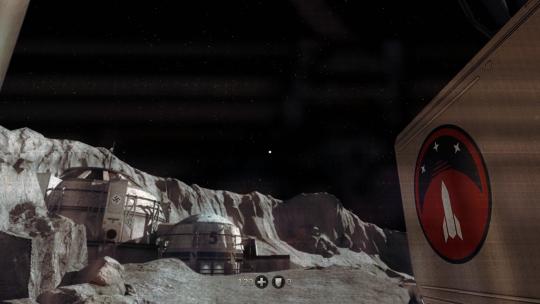
I wasn’t kidding about the Moon. Look Ma, I’m in space! (In a video game...)
The game is quite aliased on the consoles. You definitely see sharp and jagged edges at times. Plus the textures look a bit low-res when viewed up close, but the game still looks great, and I imagine the PC version cleans up most of this stuff anyway so there’s that.
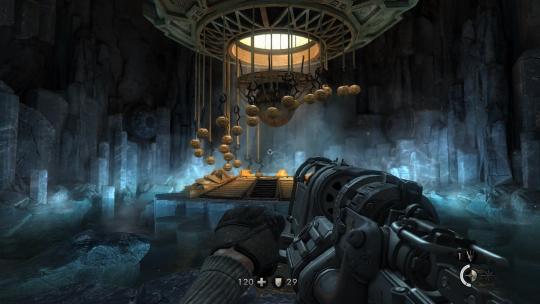
Tumblr’s image compression doesn’t do this environment justice. Oh well. C’est la vie, I suppose...
I can’t fault the game’s sound though. All voice performances are pitch-perfect with Brian Bloom (the voice of B.J.) being the standout. The music is incredible too with a great balance between atmospheric tracks and hard edged ones when the action really kicks off. It’s composed by a guy named Mick Gordon. Don’t think he’s done anything of note since though.
In terms of length, you’re looking at about roughly 8-10 hours for a first time playthrough. There is replay value with the collectibles and the Timeline system. To briefly explain, the Timeline system is related to a choice you make at the start of the game which changes some of the characters you encounter during the game. It doesn’t drastically change much. The events remain the same. You just get some unique dialog and a scene or two. Not much else.
So as you can see, I think that Wolfenstein: The New Order is still a bloody good time. The shooting still feels great with some really meaty weapons, the story and characters are super engaging, and the presentation and sound still kicks some ass. It has some minor issues here and there, but this game is well worth experiencing. You can pick it up pretty cheap nowadays on most of the platforms and it does go on sale quite often.
It’s nice to go back sometimes and revisit a classic, isn’t it?
Check back here soon for Part 2 of this where I take a look at The Old Blood. Until then, stay safe, folks!
13 notes
·
View notes
Text
GUNDAM WING review
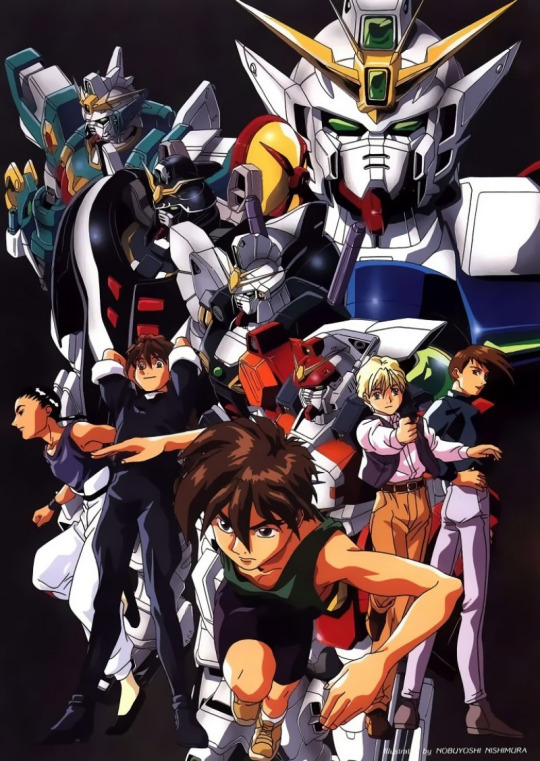
For how much of it appears on this blog, Pokemon is more “comfort food” entertainment than a great passion of mine, and the same was true when I was a child. Back in my late grade school days, the two shows that dominated my thought, my viewing schedule, my play and my early writing were Dragon Ball Z and Gundam Wing. Like a lot of kids, I can thank Toonami for that. But while I’ve checked in on Dragon Ball, off and on, since those days, I haven’t seriously revisited Gundam Wing since it left Toonami years ago. Sharing OPs with a friend on Discord led to the Wing openings coming up, however, and with the series being free to view on Crunchyroll, I thought I’d give it a rewatch.
There’s no subtle way to put this - Gundam Wing does not hold up to my childhood memories. It’s a mess of a show that frequently falls short of its own ambition. But it remains an enjoyable - even admirable - mess.
The single biggest reason that Gundam Wing is such a mess - the single biggest reason for nearly all of its flaws - is that it’s too short. At 49 episodes (two of which are given over to a clip show recap halfway through), the show isn’t long enough to contain all the story it wants to tell. By way of demonstration, and for those who don’t know/remember the series, I tried to summarize the basic plot of the series in just a few paragraphs here.
Look at that. Look at all that text in a basic outline. That was me paring away all but the most essential details needed to understand what happens in the series. Now imagine trying to fit all of that into 47 episodes while also including character interaction and development, action sequences, aesthetic elements, and a good chunk of essential information being revealed via backstory and vague insinuations only fleshed out in the OVA and manga series.
Things start out promisingly enough, with the action beginning on Operation Meteor and the initial conflict emerging gradually. But it doesn’t take long for the brevity of the series to work against the intrigues happening within it. To say that the show falls into “tell, don’t show” would suggest that it gets across more information than it actually does. Narration opens most episodes with some degree of recap, and occasionally within episodes, but this device is established from the first episode and is usually effectively used in the context of ongoing action. The problem spots are where the show neglects to tell or show almost anything.
Because the series is so short, and because all screentime is spent with either the series leads or the major supporting characters, there’s never an opportunity to showcase the state of world and colonial affairs, and little opportunity taken to describe them outside of the opening narration. Consequently, any feeling of oppression, subjugation, or desperation for the colonies - and thus, a sense of what the Gundams are fighting for - isn’t present at the beginning of the series, and doesn’t ever really emerge. There is some sense of danger towards the end of the series, but it results from the various conflicts that happen within the show, not the state of affairs from the initial premise. Earth’s condition is similarly underdeveloped; if anything is showcased on Earth, it’s beauty. Characters will occasionally talk about the desperate straits of the Gundam pilots, and the pilots themselves will take developments like the targeting of the colonies or their betrayal to heart. The VAs and the animation are strong enough to sell such developments, but the lack of world-building to support them does hurt the series.
But it’s the developments around the Sanc Kingdom and Relena’s relevance to the story suffer the most from the show’s failure to show or tell. After Zechs liberates the kingdom, Relena’s installation as its ruler is set up but never depicted. Relena’s outreach to other nations, and her building up support for total pacifism, is also never shown, and barely discussed. She and Zechs are never even seen to have a conversation until near the very end of the series. There’s plenty of discussion of how inspiring and charismatic Relena is, and why she should be heeded and protected, but with none of the work behind that charisma shown and little of it discussed in detail, there’s little emotional resonance to be had here. Relena’s efforts as queen of the world are slightly more fleshed out, but when Zech’s declaration of war against Earth happens in the same episode - happens, if memory serves, less than a second after Relena makes significant inroads - the notion of Relena as an effective spokeswoman for pacifism is severely undercut by the series’ own haste.
Beyond the plot, all of this naturally damages Relena’s character. Relena begins the series as a somewhat bratty, somewhat depressed girl often neglected by her family due to her stepfather’s job, who finds Heero’s sudden presence in her life a vicarious if dangerous thrill. The murder of her stepfather and the revelation of her true identity further shake her out of teenage ennui and move her to take part in the great events of her time. Like the show itself, it’s a promising beginning, but because Relena’s greatest achievements are glossed over - and because, being a pacifist and a diplomat, she can’t be involved at the point of action - Relena ends up spending a lot of time on the sidelines, looking grim or worried. Worse, when the final conflict between Treize and White Fang emerges, Relena is completely ineffectual at trying for peace with Zechs, and any opportunity for her to use the soft power of her (brief) reign as ceremonial monarch to further the cause of peace isn’t taken, leaving her largely irrelevant to the finale. Relena is less a full-fledged character in Gundam Wing than a solid concept for a character that couldn’t grow to fruition in the time allotted.
The same could be said of the series protagonist, Heero Yuy. In his case, there is at least a bit more told; his scientist mentor describes him as a kind-hearted young man whose devotion to his mission has rendered him a dangerous assassin, Relena instinctively latches onto what kindness and idealism she can sense in him, various characters are inspired by his skills and his devotion to his mission. But there’s little to no evidence of the kind-hearted young man underneath the child soldier, at least not in the initial episodes. We only see the cold-blooded Gundam pilot, and that pilot has the worst starting luck out of any of them, from his Gundam being brought down to his attempts to destroy it failing. His willingness - even eagerness - to die for his cause comes up so often in the beginning of the series that it ends up losing its punch. But being the series lead, and getting more screentime by dint of being a Gundam pilot, Heero does ultimately get fleshed out more than Relena. His remorse over inadvertently killing the Alliance pacifists and his blunt but pragmatic advice to the other Gundam pilots do let his softer side emerge later on. His struggle to find a reason to keep going in the fight in the middle of the series - something multiple characters go through - is rather muddled (not helped by some obtuse and stilted dialogue, another major fault in the series), but he comes out of that mess resolved to protect Relena and defeat White Fang - so much so that he not only unites with the other pilots, but designates Quatre Raberba Winner as their leader instead of himself because he recognizes what’s best for the team. The series ultimately benefits from his being the main character because of developments like this, but the journey is more awkward and choppy than it needed to be, and his romance with Relena and rivalry with Zechs are never fully convincing even if their basic mutual interest in one another is.
Stilted dialogue more than absent material is what most works against series antagonists Zechs and Treize, though Zechs’s lack of scenes with his sister and an abrupt jump from Sanc Kingdom spokesman to genocidal avenger are an issue. The philosophical notions that pepper Zechs’s and Treize’s monologues and conversations - the nature of war, the value of soldiers’ sacrifice, mankind’s natural proclivities, the possibility of peace and what it would take to achieve it - are all fascinating, and I’m still amazed that a show that spent so much time on these subjects was put in an afterschool block bound to attract younger kids back in the day. But for every speech that’s thought-provoking and emotionally resonant, there are three that are a chore to sit through and a puzzle to comprehend. Granted, the Crunchyroll subtitles for this series aren’t the best, so that may partly explain and excuse this problem. But especially in the middle of the series, where allegiances shift and motivations collapse, having the principle antagonists be so difficult to understand isn’t ideal.
Then there are the plot holes - mostly characters who somehow survived apparent deaths with little to no explanation - and characters who just don’t work. One of them is unfortunately a Gundam pilot - Chang Wu Fei, an arrogant misogynist wrapped up in his own ideals of combat who resists any teamwork or even temporary alliances with his fellow Gundams until the very end of the series, and is an unreliable partner even then. None of this would make him a bad character - one hardly needs to be likable or relatable to be an effective and compelling presence in a story - but Wu Fei has virtually no chemistry with the other Gundams, or any character, when actually does interact with them, except for ex-Alliance soldier Sally Po. His standoffishness and stoicism are traits shared by Heero and Trowa Barton, making his seem redundant, and his professed ideals of combat are muddled by bad dialogue. His great rivalry with Treize is also on shaky ground; they only interact twice in the entire series. But Wu Fei is at least comprehensible; Dorothy Catalonia, a Romefeller spy who takes an almost sexual delight in war, is not only obnoxious and intrusive when she appears in the second half of the series, but her motivations seem to swing wildly, her allegiances impossible to follow, and I sorely wish she had died by the end of the series.
With all of those faults laid bare - I did say the show was enjoyable and admirable in spite of everything, and indeed it is. Wu Fei may be redundant and Heero only a partial success as a character, but the other three Gundam pilots are well-realized, so much so that I’m baffled to see various critiques of this show imply that they’re static and one-note. Duo Maxwell is essentially the same person at the end of the series as he was at the beginning, but he’s a wonderful source of levity in the series, and he does have his trials and his low points that contrast well with his typical personality; his moments of anger and despair are some of the best in the series for selling the stakes of the conflict in the absence of proper world-building. Trowa, while much less emotive, goes through a significant journey, with his sibling-esque relationship with circus performer Catherine far more emotionally satisfying than either the Peacecrafts’ bond or Heero and Relena’s romance.
And then there’s Quatre, my new favorite character from this series. I didn’t take a great deal of notice of him as a kid, but rediscovering his story has been my favorite thing about this rewatch. A bright, gentle, and friendly personality, disdainful of violence but prepared to fight for a worthy cause, driven to despair and madness by the loss of his father and the ZERO system, only to emerge as the repentant leader of the Gundams, instrumental in bringing them together as a unit and binding them to Relena’s ideals; of all the pilots, he sees the most growth and change, and all the essentials to his story actually make it on screen. He also has the allegiance of the Maganac Corps, a group that doesn’t have a great deal of importance to the series...but they do have a cool name and cooler mobile suits.
And if Relena is somewhat lacking as a female lead, Gundam Wing does have Sally Po, military doctor turned guerrilla fighter and stalwart Gundam ally, and Lucrezia Noin. For a character that could easily have just been Zech’s love interest, Noin sees a degree of growth throughout the series to rival Quatre’s, moving from OZ instructor to Sanc Kingdom defense captain to the instigator of the Gundams as a unit, working to defeat the man she loves. The show also avoids sexualizing any of its female cast, so - a point for that, I guess.
The designs of the Gundams are all unique (as are their abilities), and some are downright beautiful. The other mobile suits are varied as well and easy to identify, making combat easy to follow. The quality of the combat - and the animation in general - is hit and miss, but it’s never atrocious, and when it’s solid, the end result is some great shots and action. The series also boasts a fantastic soundtrack, with lovely instrumental themes and two great opening songs (though why “Rhythm Emotion” was brought in with only ten episodes left to go on the series still baffles me.)
All this contributes to Gundam Wing being enjoyable, but what makes it admirable is actually the stilted dialogue and overstuffed story that bring it down. To attempt a series that ruminates on the nature of war and the various philosophical positions around its necessity or lack thereof, of the chances for real peace, for the evolution of humanity if were to move into the stars, and the interpersonal conflicts between various characters, would be a tall order for any series, and not the easiest thing to make into visually compelling animation. That Gundam Wing made the attempt at all shows ambition and aspiration on the part of its writers and staff. As I’ve said at length here, it was frustrated by its short running time and the weaknesses of story elements and characters, but an ambitious mixed bag - even a failure - that aims high is a much more admirable (and interesting to watch) affair than a success that aims low.
And, in its failures to get certain elements across, Gundam Wing shows enough of what it was trying to do that I, at least, can forgive some (not all) rough patches. Characters like Heero and conflicts like the Gundams’ basic fight for the colonies still work despite their flaws. And the final run of episodes, where White Fang and Treize clash and the Gundams work around the battle to save the day, are incredibly strong. It’s a finale that surpasses much of the content preceding it, and if it would’ve been improved by that content being better, it still works because the intent of that earlier content can still be perceived.
I’ve thoroughly enjoyed rediscovering Gundam Wing, and I’d like to check out the dub again when I’m in a position to renew my Hulu subscription. For now, though - there’s a certain waltz to attend to...
6 notes
·
View notes
Text
3.04: Demon in a priest costume. I’m sure the show has never revisited the subject of evil masquerading as emissaries of Heaven... >.>
This is also the episode where Ruby the demon teaches Bobby how to make new bullets for the Colt. And it all revolves around deception.
These two demons move into this small town, one possesses the priest and another possesses a bartender. They work in concert, whispering into the townspeople’s ears and convincing them to give into vice. Sam and Dean arrive expecting a “boarded-up factory town,” and find Party Central instead.
Dean’s a little tempted because of his whole “less than a year to live” thing, but he doesn’t let it distract him from the real job. (it’s just a shame he hasn’t memorized that exorcism yet... but hey at least he learns that lesson after this episode).
Sam again gets it wrong about who the demon might actually be.
Poor Richie the rather incompetent hunter wasn’t even able to suss out how he was in danger, and essentially played right into the demon’s hands. Any hunter worth his salt would know better than to fall for what Richie did...
Dean goes off to look for Richie because he suspects Bad Things Have Happened to him, while Sam goes haring off on the wrong lead... not giving Dean any of the details. Because if he had, Dean would’ve told Sam what he’d learned about the bartender. The shady characters Sam went after turned out to be humans (like the weirdo he ran after in 4.05 who also turned out to be human). I mean, these guys were kinda scumbag-ish humans, but they hadn’t been the ones possessed by the demons who were causing all these problems.
Gosh isn’t talking to each other a good idea? Coulda saved a lot of trouble. Because Dean had zeroed in on the REAL evil thing, by tracking Richie. He’d found the demon’s lair, discovered Richie’s body, and set a trap for her. Dean was two steps of her, but she was a few steps ahead of him.
(to be fair he’s gradually getting better at this game, but he had an awful lot of catching up to do back then)
Dean ends up on even footing with Casey the demon, both equally trapped together, both waiting for their “partner” to come free them.
Look, we won't have any effect on the outcome of this.
Aah, the beginning of Free Will being the highest ideal of humanity. Dean is absolutely not prepared to just lie down and accept whatever happens.
CASEY: Kind of funny, don't you think? You and me sitting here like a couple of regular folk. DEAN: Yeah, it's hilarious, you know, in that ... apocalyptic sort of way. CASEY: You're all right, Dean. (DEAN scoffs.) The others don't describe you that way. But, you know, you're — you're likable. DEAN: A demon likes me. Sorry, I don't know how to respond to that. CASEY: You could say thanks. (pause) That deal you made to save Sam — a lot of others would mock you for it, think it was weak or stupid. I don't. DEAN: It's been kind of liberating, actually. Y’know, what's the point in worrying about a future, when you don't have one?
Which leads to a rather strange moment for Dean. He has a chance to talk to this demon for a while, and starts to see her as a person. Partly because after she reveals that the Big Plan that was supposed to begin after Azazel opened the Devil’s Gate, that Sam was supposed to lead their army to victory... and she’d been ready to follow Sam.
But then Sam killed her over Dean’s protests, sowing the seeds of doubt about Sam:
DEAN: That maybe when ... Sam came back from (shrugs) well wherever, ... that maybe he came back different. BOBBY: Different how? DEAN: I don't know. Whatever it was, it didn't sound good. You think ... think something's wrong with my brother? BOBBY: (pauses briefly) No. Demons lie. I'm sure Sam's okay. DEAN: Yeah. Yeah, me too.
But we see what’s really different about Sam... the little “fallen angel” on his shoulder (in Ruby’s own words as she manipulates him into believing he’s doing the right thing... as he’s threatening to kill her with the Colt she’d just “fixed” for him...)
RUBY: This won't be easy, Sam. You're gonna have to do things that go against that gentle nature of yours. There'll be collateral damage... But, it has to be done.
Sam really believes he’s doing the right thing, and hiding the truth from Dean because he KNOWS Dean would try and stop him.
That doesn’t sound anything like s12 at all...
16 notes
·
View notes
Text
Game of Thrones - WHAT WAS THE POINT OF ALL THAT?
We live in an interesting time...most people don’t read the most popular book or watch the most popular play and then wait for a few months so that philosophers or English professors can analyze it. Instead, whenever the latest movie or TV show drops, we wait about eight hours for popular YouTube channels to do their work. They highlight symbolism, memorable quotes, possible meanings. It’s a very quick and difficult thing that these critics do, but it almost has to be rushed.
Screen Rant’s Pitch Meeting, which is now famous for parodying things at an extremely fast rate (they paradied a trailer roughly two hours after it aired), criticizes the series finale of Game of Thrones for being rushed. Reddit criticizes the finale for being rushed. Wisecrack, I think, offers the best analysis. Instead of polluting its content with constant bashing, Wisecrack tries to be fair to the genre, to the influences at play, and to the work as a whole.
Then, after waffling about what the last season of Game of Thrones was trying to say or why it was executed this way, Wisecrack joins the herd and bashes the finale like everyone else.
Critics don’t have very much time to criticize. If Wisecrack took any longer to release their analysis of Game of Thrones, everyone probably would have lost interest. But I’m not wisecrack. I can write whatever I want, whenever I want about this show and I don’t have to worry if everyone or no one reads it.
*Spoilers*
Game of Thrones has always been a show with political elements, and it addresses this genre rather brilliantly. In the worst movies I know, the villains aren’t fleshed out at all--they exist solely to give the plot some sort of structure, and to give the heroes of the story something to struggle against. In a lot of bad stories, but even in some stories I admit are well-written like Harry Potter and most superhero movies, the villains do little more than “mustache-twirling”: They lay out their plans, they elicit fear, and then that’s all they do. Maybe there’s backstory, maybe there’s not. But once put on the throne, the dark lord is just dark.
But in Game of Thrones, the whole concept of a villain is subverted and then made awesome. It shows a war from every point of view. Right off the bat we’re introduced to Eddard, who first distrusts and then outwardly fights against members of a different house, and all along we’re introduced to Tyrion, who is a sympathetic character but who belongs to the other house. We don’t get to have Theon as a POV character until the second book, and we don’t get to have Jamie as a POV character until the third. We don’t just catch a glimpse of the so-called villains, we get to experience the world through their eyes. We get to read their thoughts. We get to know them.
It’s already been ten minutes, so let me see if I can now run through some of the series’ major themes, touch on how I feel about the ending, and then try to decide what I think the show was trying to say.
*****
So on one hand, we have the political. House struggles against house. Every victory makes two future defeats, every act of murder results in more enemies. It’s awesome. Everyone struggles. Eddard dies, not in spite of his honor, but because his honor gets him killed.
On and on it continues. Robb puts love above all else, and he dies. Joffrey puts power above knowledge and love and honor, and he dies in the exact episode in which he uses a sword to cut a history book in half and then indulges in his own parody of history. Really cruel people die. Really great people die. It, like real-world history, seems random but makes sense the deeper you go.
But on the other hand, the show has always been about the mythical, the magic. Does the Red Woman really carry out the will of the one true God, or is she simply a sorcerer who burns one child too many and has trouble redeeming herself for it? Are the northerners empowered by their relationship to the many gods, or is that religion just their way of grappling with the mysteries of children of the forest and ice zombies? It’s not clear which religion is correct, if any of them, but it’s very clear that the magic and the mythical is real.
(17 minutes. Gosh, I really need to speed this up)
So in my mind, Dani was always a representation of the mythical. Here’s this woman who was essentially a sex slave sold against her will for power, and she just triumphs at every turn. I loved this about the show. Married off to a supposed savage, she finds kindness. Having lost everything, including the one person she really loves, she goes into a fire and is then shielded by dragons that emerge from eggs. For the first few seasons, every time the shit really hit the fan Dani would emerge as the one likable character who triumphed. Eddard is beheaded? Sure, but at least Dani rises. Blackwater is devastating? Okay, but check out how Dani reclaims her right. All your favorite characters just died in a freaking wedding? Okay, but Dani just took a city.
Some have argued that she was always meant to go insane, as a character, but I’m still having trouble accepting it. I thought her signs of “madness” were meant to ultimately reveal that her justice would triumph, and weren’t given as hints as to what she would become. Are the Targaryens just crazy? I would argue that the Targaryens were a representation of the mythical. If they were really embodiments of madness, then what about her brother? Why was there a shocking reveal about her brother actually being someone who died for love? Why put such emphasis on how her brother was talented but also humble, how her brother was an obvious indication that her family wasn’t just madness and fire?
22 minutes. Let me wrap this up with the political.
In the end, we’re left with the resolution that monarchy will be replaced by oligarchy, and Bran will rule over all. I think this might make sense, but we don’t really know why. Bran seems detached, something more than human, but someone who doesn’t seem like the ruler of all these humans. Wisecrack points out that Tyrion tries to arrange the chairs of his small council, and they quickly undo his work. Wisecrack points out that you get a final cutaway, and you see that on the map on the ground Westeros is cracked.
But I think the line about stories being the unifying force in their world was meant to be something like the point of the show. I think that their burning the throne in dragon fire was meant to be some triumph. I think that we were supposed to feel liberated, Jon and Arya having freedom, Tyrion having freedom, the land being free. I think we were supposed to feel good. Optimistic.
But I’m not. I still can’t get over how significant the mythical theme was throughout the series, and how quickly they wrapped up the Night King as disappearing with a single blow, and Dani simply being “the mad queen all along.”
26 minutes. If anything was rushed, it was this post.
0 notes